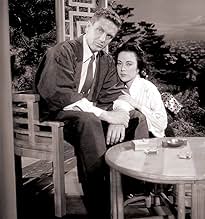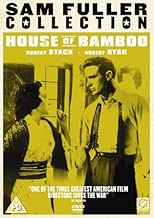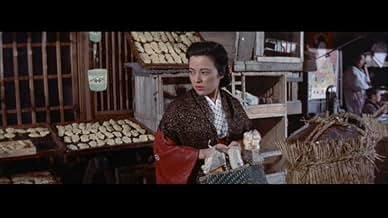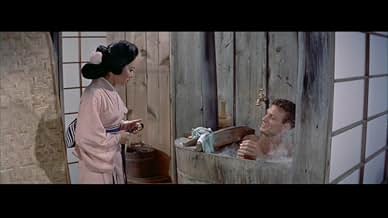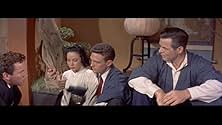CALIFICACIÓN DE IMDb
6.8/10
4.4 k
TU CALIFICACIÓN
Instalado en un sindicato del crimen de Tokio, un investigador del ejército de los Estados Unidos intenta investigar la muerte coincidente de un compañero oficial del ejército.Instalado en un sindicato del crimen de Tokio, un investigador del ejército de los Estados Unidos intenta investigar la muerte coincidente de un compañero oficial del ejército.Instalado en un sindicato del crimen de Tokio, un investigador del ejército de los Estados Unidos intenta investigar la muerte coincidente de un compañero oficial del ejército.
- Dirección
- Guionistas
- Elenco
Clifford Arashiro
- Policeman
- (sin créditos)
Sandy Azeka
- Charlie's Girl at Party
- (sin créditos)
Harry Carey Jr.
- John
- (sin créditos)
Barry Coe
- Captain Hanson's Aide
- (sin créditos)
John Doucette
- Skipper
- (sin créditos)
Fuji
- Pachinko Manager
- (sin créditos)
Samuel Fuller
- Japanese policeman
- (sin créditos)
Peter Gray
- Willy
- (sin créditos)
- Dirección
- Guionistas
- Todo el elenco y el equipo
- Producción, taquilla y más en IMDbPro
Opiniones destacadas
I vacillate on whether the 20th Century Fox studio claim that HOUSE OF BAMBOO is film noir is really accurate or not. For one thing, it's in color. For another, it's shot in Cinemascope. Also given it's made in 1955, I have to think of it more like a new gas/electric car: it's a hybrid. But unlike most compact hybrids out these days, this one's a full-size truck.
There are action sequences that feel more like they belong in Frankenheimer's THE TRAIN or Sturges' THE GREAT ESCAPE than in a so called noir picture, but I'm not knocking them. They're well staged, and like the entire film, terrifically photographed. But then there is the use of silhouette and high contrast more akin to noir, and the story too feels more in that vein, although more on the sparse side; certainly not a Raymond Chandler THE BIG SLEEP kind of story! Honestly, I found it no less thin a story than Fritz Lang's THE BIG HEAT. As critical as the story is, if films were only that, I'd just be reading books. What's done visually plays a pretty big part in this format.
Speaking of the cinematography, some critics have stated the widescreen use is overkill here, but I must beg to differ. With so many modern films shot more and more like television, with only close-ups and two-shots, and barely a moment of establishing frame to see where everything is happening - and with action sequences and dance numbers shooting this way now - it was refreshing for me to see the entire frame used, with characters often at either end, and action allowed to play out wide, without fast moving camera-work to pump it up. Of course the problem is that many will view a DVD of the film now, where wide shots just look far away (unless you've got a large home theater screen). But that's not the fault of the filmmakers - Cinemascope was meant for the big screen.
When the camera does move, it's clever work. The blocking is also terrific and surprisingly fresh (or again perhaps just not used anymore and so fresh all over again to my eyes). Some say it's all too tricky, but it's far less tricky than all of the motion-control work we're used to seeing now, and often (in this film at least) more involving. Director Samuel Fuller is doing the right shots at the right time here, and that takes everything on screen up a notch.
I'm not sure why there's criticism over the location, but I found the setting in post-war Japan to be as crucial to HOUSE OF BAMBOO as post-war Vienna was to THE THIRD MAN, or for that matter Monument Valley to a John Ford western. Sometimes the setting becomes one of the characters, which when done right as it is here, can only be a plus for the picture. Fuller puts it all to good use. Perhaps it's the Hollywood techniques brought into play, but I can't think of another picture, including all of Kurosawa's work, that looks exactly like this. I'm not saying it's better, just a different take on the locations, and so enjoyable as such.
I'll make the argument that Kurosawa, for example, would film a Japan he knew, but overlooked images because he was used to them, just like I wouldn't take a picture of the Golden Gate bridge because I live 45 minutes away from it. But Fuller looks at it more like a tourist if you will, and so commits to film here things that are unique or uniquely shot. You have enough of these memorable images and you start to have a memorable film. If this were another kind of film, I might not think all those fascinating shots were of such importance. But if this is trying to be noir, then it's all about the atmosphere that the landscape and settings convey. Noir or not, it truly got me caught up in the story.
I have to admit being swayed by a great score from Leigh Harline (as conducted by none other than Lionel Newman), but that's what a good score should help to do: make a decent film good and a good film great. But I also must admit that if I just look at the pieces of this film, I would never rate it so highly. It's a case, for me at least, of the whole being greater than the sum of its parts, of everything working together just right to make a solid piece of entertainment, noir or otherwise.
There are action sequences that feel more like they belong in Frankenheimer's THE TRAIN or Sturges' THE GREAT ESCAPE than in a so called noir picture, but I'm not knocking them. They're well staged, and like the entire film, terrifically photographed. But then there is the use of silhouette and high contrast more akin to noir, and the story too feels more in that vein, although more on the sparse side; certainly not a Raymond Chandler THE BIG SLEEP kind of story! Honestly, I found it no less thin a story than Fritz Lang's THE BIG HEAT. As critical as the story is, if films were only that, I'd just be reading books. What's done visually plays a pretty big part in this format.
Speaking of the cinematography, some critics have stated the widescreen use is overkill here, but I must beg to differ. With so many modern films shot more and more like television, with only close-ups and two-shots, and barely a moment of establishing frame to see where everything is happening - and with action sequences and dance numbers shooting this way now - it was refreshing for me to see the entire frame used, with characters often at either end, and action allowed to play out wide, without fast moving camera-work to pump it up. Of course the problem is that many will view a DVD of the film now, where wide shots just look far away (unless you've got a large home theater screen). But that's not the fault of the filmmakers - Cinemascope was meant for the big screen.
When the camera does move, it's clever work. The blocking is also terrific and surprisingly fresh (or again perhaps just not used anymore and so fresh all over again to my eyes). Some say it's all too tricky, but it's far less tricky than all of the motion-control work we're used to seeing now, and often (in this film at least) more involving. Director Samuel Fuller is doing the right shots at the right time here, and that takes everything on screen up a notch.
I'm not sure why there's criticism over the location, but I found the setting in post-war Japan to be as crucial to HOUSE OF BAMBOO as post-war Vienna was to THE THIRD MAN, or for that matter Monument Valley to a John Ford western. Sometimes the setting becomes one of the characters, which when done right as it is here, can only be a plus for the picture. Fuller puts it all to good use. Perhaps it's the Hollywood techniques brought into play, but I can't think of another picture, including all of Kurosawa's work, that looks exactly like this. I'm not saying it's better, just a different take on the locations, and so enjoyable as such.
I'll make the argument that Kurosawa, for example, would film a Japan he knew, but overlooked images because he was used to them, just like I wouldn't take a picture of the Golden Gate bridge because I live 45 minutes away from it. But Fuller looks at it more like a tourist if you will, and so commits to film here things that are unique or uniquely shot. You have enough of these memorable images and you start to have a memorable film. If this were another kind of film, I might not think all those fascinating shots were of such importance. But if this is trying to be noir, then it's all about the atmosphere that the landscape and settings convey. Noir or not, it truly got me caught up in the story.
I have to admit being swayed by a great score from Leigh Harline (as conducted by none other than Lionel Newman), but that's what a good score should help to do: make a decent film good and a good film great. But I also must admit that if I just look at the pieces of this film, I would never rate it so highly. It's a case, for me at least, of the whole being greater than the sum of its parts, of everything working together just right to make a solid piece of entertainment, noir or otherwise.
This movie has similarities to THE THIRD MAN in that both involve someone (an American) living comfortably in an alien culture as a parasitic gangster in a war ravaged country just after WW2 with a good guy (another American) in pursuit. In narrow cinematic terms, in terms of the story as other reviewers point out, its not a great movie. There is though very much more of interest to it than that.
In historical terms we see Tokyo as it then was in 1954. We see the Japanese as officials, as policemen, as gangsters, the good, the bad, in their natural habitat rather than simply as massed cruel soldiery or suicidal pilots. It has elements of a travelogue with a fascinating glimpse behind the rice paper screen. The movie, which has really handsome colour photography, starts with the curious beauty of a snow covered landscape with Mount Fuji in the background and a murderous attack on a military supply train in the foreground. The ending too shares the same deliberate disjunction - dark violent justice dealt out in a sunny family setting - Top of the World, Ma?
Robert Stack here very much pre-figures his role as Eliot Ness in THE UNTOUCHABLES - dogged and brave in the fight against organised crime. Robert Ryan, tall impeccably elegant and seemingly entirely at ease as a violent mobster in a very foreign land.
Much criticism seems carping and misses the point. As was said of the dog that could walk upright - the question was not so much that he couldn't do it perfectly but that he could do it at all. This was a unique bold movie embedded in post WW2 underworld Japan really striving for authenticity. Not the customary montage of tourist sites and hotel interiors with a cast looking as if they'd gone no further than that themselves.
Were there American gangsters in this way in post war Japan? Presumably so if CATCH 22 is any guide. In this movie however the morality is old-fashioned, certain and unambiguous. By 1970 CATCH 22 served up satire and moral ambiguity to the Hippy generation.
A fascinating little bit of history as well as being a very watchable movie
In historical terms we see Tokyo as it then was in 1954. We see the Japanese as officials, as policemen, as gangsters, the good, the bad, in their natural habitat rather than simply as massed cruel soldiery or suicidal pilots. It has elements of a travelogue with a fascinating glimpse behind the rice paper screen. The movie, which has really handsome colour photography, starts with the curious beauty of a snow covered landscape with Mount Fuji in the background and a murderous attack on a military supply train in the foreground. The ending too shares the same deliberate disjunction - dark violent justice dealt out in a sunny family setting - Top of the World, Ma?
Robert Stack here very much pre-figures his role as Eliot Ness in THE UNTOUCHABLES - dogged and brave in the fight against organised crime. Robert Ryan, tall impeccably elegant and seemingly entirely at ease as a violent mobster in a very foreign land.
Much criticism seems carping and misses the point. As was said of the dog that could walk upright - the question was not so much that he couldn't do it perfectly but that he could do it at all. This was a unique bold movie embedded in post WW2 underworld Japan really striving for authenticity. Not the customary montage of tourist sites and hotel interiors with a cast looking as if they'd gone no further than that themselves.
Were there American gangsters in this way in post war Japan? Presumably so if CATCH 22 is any guide. In this movie however the morality is old-fashioned, certain and unambiguous. By 1970 CATCH 22 served up satire and moral ambiguity to the Hippy generation.
A fascinating little bit of history as well as being a very watchable movie
It is 1954 in Tokyo and American soldiers and local forces are working together to protect shipments of ammunition moving around the country. Whenever a group of men rob one such shipment and kill one of the US guards, the US army get involved in the investigation along with the local police. The trail is cold until a different turns sour and an injured criminal is finished off by his own gang using the same gun that killed the US guard. The man dies of course and turns out to be a former US GI; days later the dead man's friend (Eddie Spanier) turns up in Tokyo and, finding his friend dead and no hope of work turns to the protection racket, bringing him to the attention of the same gang his friend was in a gang run by former US soldier Sandy Dawson. Eddie gets into the gang thanks to his criminal record a record falsified by the army in order to get him on the inside and take the gang down.
The daytime cable stations are littered with crime b-movies from the 1950's etc and they all pretty much try to stay to the same formula, what made me sit to watch this one though was the presence of Sam Fuller in the director's chair. The plot here is a typical crime thriller regardless of the Oriental setting and we have a man infiltrating a tough gang to bring it down. As a story it kinda goes where you expect it to and has some elements that don't really work but overall it is tough and gritty enough to entertain for the most part. The Oriental setting appears to be only a novelty and it isn't used to any great effect, with only Japanese stereotypes making it onto the screen and no real sense of place this could have been Chicago for all the difference the location makes to the story. The script makes up for this though by throwing in plenty of tough dialogue for the cast to work with and it is impressive in a typical b-movie fashion; meanwhile Fuller does frame a good shot and add a tense edge to the telling, even if he doesn't use his Japanese cast that well.
Stack and Ryan were another big draw to me; maybe not known as the best actors in the world but they can do gritty well enough for this film to work. Stack is good value as he does suggest angry layers to his character even if we are not allowed to see them certainly some sense of "justice" seems to drive him to take such risks for little pay and his demeanour backs this up. Ryan is much more relaxed and he suits the gang leader role, nicely cracking a bit towards the end. Using Yamaguchi seemed a bold move but really she is as American as you could get without using a white actress in gap jeans; her character is a little interesting but is ignored in favour of the tougher male dynamics within the film. The support cast are OK and buoy up the tough aspect of the film but really it is Stack and Ryan who own the film and it is best when they share tough scenes together.
Overall this is a standard b-movie that is worth seeing on that level while also having enough else going for it to make it an enjoyable film. Fuller's direction may not make great use of his exotic location but he still directs well whether it be tough talk on sound stages or the brutal shoot out on the fairground, high above the Tokyo streets. Stack and Ryan play off each other well and the dialogue is tough and crisp, making it an enjoyable piece of b-movie entertainment.
The daytime cable stations are littered with crime b-movies from the 1950's etc and they all pretty much try to stay to the same formula, what made me sit to watch this one though was the presence of Sam Fuller in the director's chair. The plot here is a typical crime thriller regardless of the Oriental setting and we have a man infiltrating a tough gang to bring it down. As a story it kinda goes where you expect it to and has some elements that don't really work but overall it is tough and gritty enough to entertain for the most part. The Oriental setting appears to be only a novelty and it isn't used to any great effect, with only Japanese stereotypes making it onto the screen and no real sense of place this could have been Chicago for all the difference the location makes to the story. The script makes up for this though by throwing in plenty of tough dialogue for the cast to work with and it is impressive in a typical b-movie fashion; meanwhile Fuller does frame a good shot and add a tense edge to the telling, even if he doesn't use his Japanese cast that well.
Stack and Ryan were another big draw to me; maybe not known as the best actors in the world but they can do gritty well enough for this film to work. Stack is good value as he does suggest angry layers to his character even if we are not allowed to see them certainly some sense of "justice" seems to drive him to take such risks for little pay and his demeanour backs this up. Ryan is much more relaxed and he suits the gang leader role, nicely cracking a bit towards the end. Using Yamaguchi seemed a bold move but really she is as American as you could get without using a white actress in gap jeans; her character is a little interesting but is ignored in favour of the tougher male dynamics within the film. The support cast are OK and buoy up the tough aspect of the film but really it is Stack and Ryan who own the film and it is best when they share tough scenes together.
Overall this is a standard b-movie that is worth seeing on that level while also having enough else going for it to make it an enjoyable film. Fuller's direction may not make great use of his exotic location but he still directs well whether it be tough talk on sound stages or the brutal shoot out on the fairground, high above the Tokyo streets. Stack and Ryan play off each other well and the dialogue is tough and crisp, making it an enjoyable piece of b-movie entertainment.
No need to recap the plot. The movie's one-third caper film, one-third romance, and one- third travelogue. Cult filmmaker Fuller tries to bring them together, but only partially succeeds, despite that colorful climax with the revolving globe and the rooftop view of Tokyo. Two of Fuller's usual concerns prevail here as elsewhere—culture clash and military organization.
Mariko and Eddie must work through their cultural differences before establishing a real relationship. Screenwriter Fuller spends a lot of time with this, maybe too much since it drags out the pacing. However, I suspect he was revealing a timely cultural glimpse to American audiences—remember this was less than a decade after the war and, generally, Americans knew very little about their new Cold War partners or traditional Japanese society.
Surprisingly, the robbery capers are dealt with only briefly and without the expected rising tension. In fact, Fuller seems more interested in the para- military discipline that defines the gang than in the robberies themselves, an aspect that produces more talk than action. Getting the great Robert Ryan (Sandy) as the gang's "5-star general" was the real casting coup since it's his fierceness that delivers the film's main impact. (In passing—Griff's {Mitchell} attachment to Sandy appears ambiguous enough to be interesting for the time.)
Frankly, I liked the travelogue parts best. Fuller does a good job working these into the story, while the scenes themselves of Japanese landmarks and street crowds are colorful as heck. Anyway, the movie's too uneven and diffuse to have real impact. Still, it does remain a visual treat despite the passing decades.
Mariko and Eddie must work through their cultural differences before establishing a real relationship. Screenwriter Fuller spends a lot of time with this, maybe too much since it drags out the pacing. However, I suspect he was revealing a timely cultural glimpse to American audiences—remember this was less than a decade after the war and, generally, Americans knew very little about their new Cold War partners or traditional Japanese society.
Surprisingly, the robbery capers are dealt with only briefly and without the expected rising tension. In fact, Fuller seems more interested in the para- military discipline that defines the gang than in the robberies themselves, an aspect that produces more talk than action. Getting the great Robert Ryan (Sandy) as the gang's "5-star general" was the real casting coup since it's his fierceness that delivers the film's main impact. (In passing—Griff's {Mitchell} attachment to Sandy appears ambiguous enough to be interesting for the time.)
Frankly, I liked the travelogue parts best. Fuller does a good job working these into the story, while the scenes themselves of Japanese landmarks and street crowds are colorful as heck. Anyway, the movie's too uneven and diffuse to have real impact. Still, it does remain a visual treat despite the passing decades.
House Of Bamboo came out in 1955 three years after the Japanese Peace Treaty effectively ended the occupation of Japan that began post World War II. Americans must have been familiar sight on the streets of Japanese cities still in 1955, we certainly had enough military personnel there. If you don't recognize that fact than you will be puzzled as to how a gang of Americans crooks could operate the way they do in the streets of Tokyo.
For those of you who don't recognize it screenwriter Harry Kleiner took the screenplay he wrote for the Henry Hathaway classic, The Street With No Name and set in down in post occupation Japan. Robert Ryan plays the gang leader part that Richard Widmark had. He's recruited a gang of former military misfits who spent more time in the stockade than in combat and made them into an effective heist gang. Ryan's got other interests, but his main income is from some well planned robberies.
The USA military intelligence gets involved when Ryan hijacks a train with military hardware and kills a soldier. Going undercover is Robert Stack in the Mark Stevens part.
Unlike The Street With No Name, Stack's allowed a little romance here in the person of Japanese actress Shirley Yamaguchi. In The Street With No Name it was Widmark who had the girlfriends and Stevens was strictly business. Sessue Hayakawa is also in the cast as the Japanese police inspector.
There's a gay subtext in the film with the relationship of Ryan with his number two, Cameron Mitchell. When Stack starts to take his place in the gang hierarchy, Mitchell reactions are of pure jealousy. In fact Mitchell's reactions are what sets in motion the climax of the film.
Which you know if you've seen The Street With No Name. House Of Bamboo boasts some mighty nice location shots of postwar Tokyo which looking at it you would hardly believe what a difference a decade might make. The title House Of Bamboo is the place that Ryan lives in and it's a pre-war structure typical of the Tokyo before General Doolittle inaugurated US bombing raids. Those wooden houses went up like tinder boxes. Note the more modern look Tokyo has in 1955.
The color might disqualify House Of Bamboo from the genre, but the film as the look and feel of a good noir film. Which is as good a recommendation as I can give it.
For those of you who don't recognize it screenwriter Harry Kleiner took the screenplay he wrote for the Henry Hathaway classic, The Street With No Name and set in down in post occupation Japan. Robert Ryan plays the gang leader part that Richard Widmark had. He's recruited a gang of former military misfits who spent more time in the stockade than in combat and made them into an effective heist gang. Ryan's got other interests, but his main income is from some well planned robberies.
The USA military intelligence gets involved when Ryan hijacks a train with military hardware and kills a soldier. Going undercover is Robert Stack in the Mark Stevens part.
Unlike The Street With No Name, Stack's allowed a little romance here in the person of Japanese actress Shirley Yamaguchi. In The Street With No Name it was Widmark who had the girlfriends and Stevens was strictly business. Sessue Hayakawa is also in the cast as the Japanese police inspector.
There's a gay subtext in the film with the relationship of Ryan with his number two, Cameron Mitchell. When Stack starts to take his place in the gang hierarchy, Mitchell reactions are of pure jealousy. In fact Mitchell's reactions are what sets in motion the climax of the film.
Which you know if you've seen The Street With No Name. House Of Bamboo boasts some mighty nice location shots of postwar Tokyo which looking at it you would hardly believe what a difference a decade might make. The title House Of Bamboo is the place that Ryan lives in and it's a pre-war structure typical of the Tokyo before General Doolittle inaugurated US bombing raids. Those wooden houses went up like tinder boxes. Note the more modern look Tokyo has in 1955.
The color might disqualify House Of Bamboo from the genre, but the film as the look and feel of a good noir film. Which is as good a recommendation as I can give it.
¿Sabías que…?
- TriviaAccording to Robert Stack, Samuel Fuller told an actor to go down really low when he passed a 50-gallon drum. Without informing the actor, the director had a sharpshooter on a parallel who shot over the man's head and into the drum. After it blew up, the actor said, "Jesus Christ! Those were real bullets!" Fuller laconically replied, "Don't worry. He knew what he was doing."
- ErroresSandy fires an awful lot of shots from his pistol (which is a revolver) without ever appearing to reload it.
- Citas
Sandy Dawson: Who are you working for?
Eddie Kenner: [posing as Eddie Spanier] Spanier.
Sandy Dawson: Who's Spanier?
Eddie Kenner: Me.
Sandy Dawson: Who else you working for?
Eddie Kenner: Eddie.
- ConexionesEdited into Delirio de pasiones (1963)
Selecciones populares
Inicia sesión para calificar y agrega a la lista de videos para obtener recomendaciones personalizadas
- How long is House of Bamboo?Con tecnología de Alexa
Detalles
- Fecha de lanzamiento
- País de origen
- Idiomas
- También se conoce como
- House of Bamboo
- Locaciones de filmación
- Tokio, Japón(rooftop playground of the Matsuma department store)
- Productora
- Ver más créditos de la compañía en IMDbPro
Taquilla
- Presupuesto
- USD 1,380,000 (estimado)
- Tiempo de ejecución1 hora 42 minutos
- Relación de aspecto
- 2.55 : 1
Contribuir a esta página
Sugiere una edición o agrega el contenido que falta

Principales brechas de datos
By what name was La casa del sol naciente (1955) officially released in India in English?
Responda



